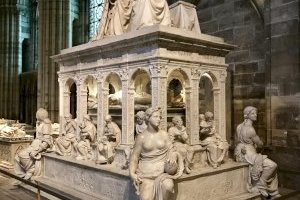
When you take the relatively short way from the centre of Paris to Saint-Denis you are not sure if you really went the right way. You are still very much in Paris but the quarter is rather poor and and as a caucasian north European you feel like a stranger among a largely arab crowd. Street vendors enhance the exotic feeling. When you stand in front of the building the doubts are not resolved: The asymmetrical facade with just one tower looks rather clumsy and unfinished despite the beautiful portals. The modern arge square in front does not help the impression.
And what a difference once you enter: One of the most important buildings in European history with the first choir that resolved the walls into windows. When I visited the weather was cloudy and dark but you could still get an impression of the light effects. But I definitely have to return there once with sunshine. If you follow the history of the early gothic buildings this is the key monument and Abbé Suger its great and interesting hero. If you look closer you find that the whole area of the Île-de-France was a laboratory for a new style and it is pivotal to put it in the context of the other great churches that were build around the same time in the are: the church St-Martin-des-Champs in Downtown Paris, the Cathedral Saint-Étienne in Sens (strangely also with an asymmetrical facade), probably contemporary with St. Denis, and the Cathedrals of Senlis, Noyon and Laon. The latter were planned as cathedrals, are a bit later but larger and probably more unified then Saint-Denis. Perhaps a serial approach would make more sense here in regard of the churches role in the birth of the Gothic style.
But the other and possibly even greater claim to greatness is the royal necropolis: You can visit dozens of royal tombs starting from the 10th century! This is not only an extraordinary artistic time travel but equally a trip though changing ideas about tombs and death: Many of the old royal tombs are surprisingly small and modest: Just a body laying on a bed, to their feet mostly animals (lions and dragons for the gentlemen and dogs for the ladies), nice gowns and simple attributes like crosses and swords. In some eras the dead were portrayed sleeping with closed eyes in other times looking to heaven with the eyes wide open. I assume they wanted to face god without pomp and vanity as human beings.
But there also more elaborate tombs: among the older the grave of Dagobert stands out: He was the Merovingian king from the 7th century who made Paris his capital and he was so important that his tomb was remade in the 13th century in gothic style. The most stunning tombs are from the renaissance: here the dead were sculpted twice on two levels: on the lower level they are very realistically and miserably shown as dead or dying bodies, often almost naked, on the upper level they are shown in full royal garment praying, expecting to be taken to the heavens. I think the most impressive was the tomb of Louis XII and Anne de Bretagne which is additionally surrounded by several allegorical figures. Newer but very lifelike are also the statues of Louis XIV and Marie-Antoinette.
On the lower level of the church you find a huge ossuary with all the kings intertwined: in the french revolution all the tombs were emptied and only under Napoleon were they brought back but the couldn't be identified anymore. There you find also a strange basement with broken sarcophagi that looks like an archeological roman site.
This site is not only one of the most important sites for the history of france and for the gothic style but a probably world wide unique collection to royal tombs over such a long period. Their modesty doesn't diminish their artistic value and their value for the history of ideas. It shows especially how the ideas about death and resurrection have changed over the centuries. If have the historic and artistic knowledge to appreciate the different aspects of this site you can easily spend hours here. But I think there was also a decent audio guide available.
If you compare it to Roskilde, the danish royal necropolis, it is the much better site: It spans a much longer time and the tombs are of a higher artistic level and all built in way that they harmonize with each other despite the stylistic changes. The beauty and the historic importance of the church should remove any doubt that this would be a great contribution for the list.
Comments
No comments yet.
